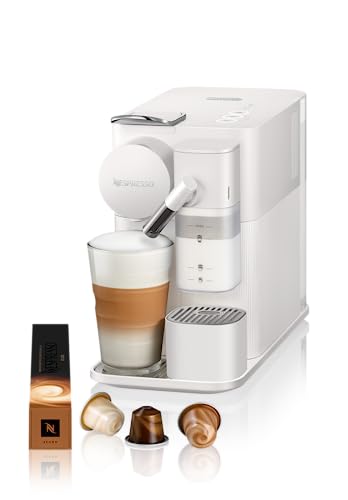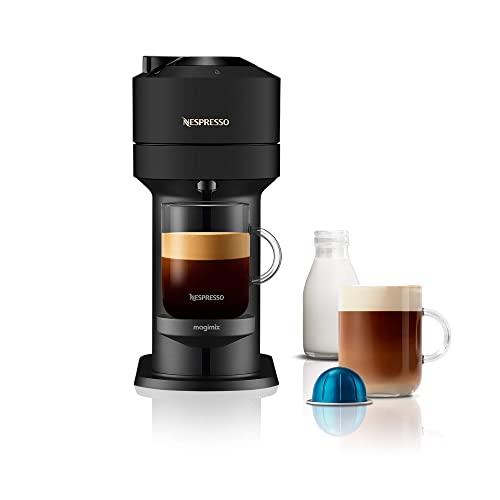10 Things That Your Family Teach You About Nespresso Coffeee Machine
페이지 정보
작성자 Melanie Pohlman 작성일24-07-16 21:31 조회355회 댓글0건본문
 Nespresso Coffee - The Essenza Mini
Nespresso Coffee - The Essenza Mini The Essenza Mini is compact and affordable. It's also easy to use. It does not have features such as a water tank or drip tray that can be removed to remain small, but it makes excellent espresso and lungo.
The Essenza Mini is compact and affordable. It's also easy to use. It does not have features such as a water tank or drip tray that can be removed to remain small, but it makes excellent espresso and lungo.It is operated by piercing capsules and then pumping hot water under pressure to create various espresso drinks and coffee sizes, such as the 1.35-ounce espresso, 2.7-ounce double espresso, 5-ounce gran lungo, and 14-ounce alto. It can be used with a milk frother that is freestanding.
Capsules
With the Nespresso system you can make your coffee at the press of the button. You can choose a single-serving size or a larger size, and each capsule contains the right amount of ground beans for your preferred strength. You can also add milk powder to make cappuccino, latte macchiato, or other drinks. The capsules are made of completely biodegradable materials and can be recycled or disposed of without guilt.
The pods are constructed of aluminium which allows them to stand up to the high pressure from the machine. The pods are sealed in a hermetically sealed manner and are tamper-proof, and the coffee grounds inside stay fresh and protected from moisture and oxygen. Nestle's sustainability goal is aligned with the fact that aluminium is completely recyclable.
The system comes with its own drawbacks. The machines are costly both to purchase and to operate. Additionally capsules can be expensive to purchase, and they have to be replaced often. The machines are also able to only be used with capsules branded Nespresso. This has led to numerous lawsuits between Nestle and third-party companies that employ the same extraction methods and ingredients as Nespresso.
Despite these limitations, the Nespresso system has many benefits, including high-quality coffee and sustainability for the environment. It's an excellent alternative to regular tea and coffee, and it has more extraction than most single-serve systems. In fact, a single capsule can make up to 14 ounces of espresso-style coffee.
The first capsule was designed in 1976, and then patented in 1978. Its main features include an aluminum foil cone container, a flat top with a cylindrical recess into which the machine injects hot water, and a small opening in the base that is punctured both above and below. The machine spins the capsule at 7000 rpm, which infuses the coffee with water, resulting in the thicker crema.
Water
It is crucial to use high-quality water when making use of a Nespresso. This helps ensure consistent quality and is important for taste and texture. It is recommended to use "filtered" water or "spring water," and avoid tap water or distillate water.
In our laboratory tests, we've discovered that Nespresso machines with top-quality, softened water make more delicious espressos and lungos than those that use hard water. This is because hard water creates calcium deposits, as well as other issues that degrade the flavor of your coffee.
During each cup of coffee The Nespresso machine infuses and then pumps out hot water at high pressure. This process is called extraction. The duration, temperature, and pressure of the extraction process is what determines the taste and intensity of your coffee.
The Original machines pierce the capsule and then pump it, while the Vertuo model scans the barcodes to determine the amount of water needed for each type of espresso. The Vertuo models can brew six different sizes of drinks including espressos and lungos with or without caps of foam.
All machines that are part of the Nespresso range provide 19 bars of pressure. Some of the more expensive machines also brew macchiatos latte and cappuccinos, and some offer the option to make an Iced Coffee.
The Inissia and U series machines have small bodies, making them easy to fit in tight spaces. The Nespresso Pixie, which has a built-in frother, is another compact option. It can also be integrated with the Magimix Black 11385 Nespresso Vertuo Plus: Coffee Machine app to access customized recipes and reorder capsules. Nespresso is an excellent choice for those who want to reduce their plastic footprint while also supporting the company's sustainability program.
Temperature
While Nespresso machines are more complicated than your average coffee maker, they are also designed for speed and user-friendliness. They are extremely fast and take only an hour to prepare each capsule. They're also fairly efficient. Contrary to traditional drip coffee makers which consume more electricity per cup of coffee, Nespresso machines only use only a tiny amount of energy to make each capsule.
The majority of Nespresso coffeee machine are designed for espresso-based drinks, but some models have milk frothers that can be used to make cappuccinos or lattes. Certain models come with a separate capsule container that can hold up to 12 capsules at once. This makes it easier to recycle.
The Nespresso brand is backed by several well-known kitchen-equipment manufacturers such as Krups, DeLonghi and Breville. However the majority of machines are manufactured by Eugster/Frismag, a Swiss company that is among the biggest coffee machine manufacturers in the world. This has prompted criticism of the company's usage of patents and other strategies similar to those used by printer makers to establish vendor lock-in.
Pressure
To achieve the best espresso, you should keep an even pressure throughout the extraction. This is known as "pressure profiling." Pressure profiling involves adjusting the amount of pressure that is applied to the coffee grounds to achieve an optimal extraction and maximize flavor. This method is possible through various espresso machines, like Nespresso coffeemakers.
There are several ways espresso machines can control the pressure of extraction. A balanced bypass keeps the water pressure to a set number, usually 9 bars, regardless of the inlet. This simple and efficient technique ensures that the pressure across all the espresso groups is the same during the extraction process.
A control knob or lever can be used to adjust pressure manually. This is a more complex method, but it does offer a higher level of customization and control. It is important to remember that manual pressure regulation could lead to inconsistent results, so it requires a lot of skill and attention.
Additionally, some espresso machines have a dynamic pump that adjusts the pressure based on the temperature of the grounds and the type of coffee being used. This type of system is more sophisticated, but can produce better results than other types.
Nespresso has a range of machines that can be used to make coffee, lungo drinks and some are also able to froth the milk. The Nespresso Inissia is a fantastic option for home baristas, as it can make seven to nine espressos at a time. It also comes with a 33-ounce water tank. The machine has buttons that let you choose different sizes of drinks, and a capsule tray which can hold up to nine pods. The Nespresso Vertuo Next is designed for versatility and has 11 milk temperatures as well as eight milk textures to select from. It also has a large, stainless steel milk frother wand and containers that can hold up to 18 ounces of capsules that have been used.
Cleaning
When you use a Nespresso machine, it leaves behind small mineral and limescale residues each time you make a cup. These residues can mix with your coffee, which can cause it to taste bad. To prevent this, it is important to regularly clean your Nespresso machine and all its parts. The removable parts such as the drip tray capsule container, washer and drip tray must be cleaned and decalked after a thorough cleaning. A daily wash of the capsule container with fresh water can also help stop the buildup of mineral.
De-scaling products can help you remove mineral deposits from your machine. These products are available in most coffee and appliance stores. You can also make use of vinegar. This gentle cleaner won't harm your machine, but it might take longer to dissolve the minerals than a descaling solution.
If you choose to make use of vinegar, you must first remove the coffee pods and empty the reservoir of water. Then, pour out the remainder of the water in the tank and any built-in water filters. Pour in the vinegar and run a brew cycle without a coffee pod to allow it to pass through the machine. Rinse the machine using clean water, and then run several times to make sure that there are no vinegar traces left.
After cleaning your machine, clean the exterior and the removable parts. Pay particular attention to crevices and corners where gunk could be a problem. You can wash the removable parts with mild soap in your dishwasher or by hand. Rinse them thoroughly. It is also recommended to examine the seals around the capsule and coffee outlet and replace them if needed to ensure their elasticity and prevent leaks.
댓글목록
등록된 댓글이 없습니다.